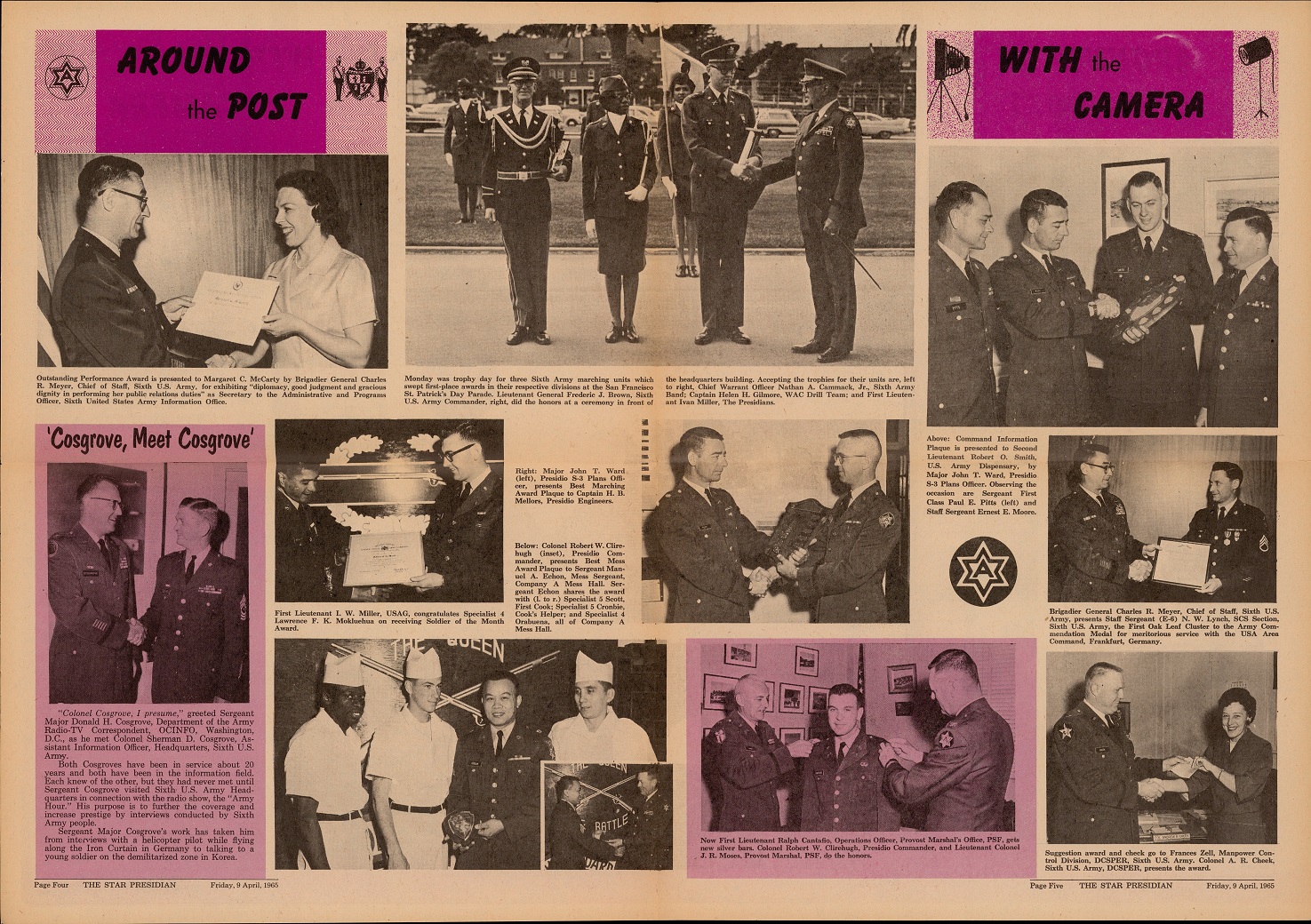
Not to say that personnel and unit records are not important! Those folks were/are the hustle and bustle of military posts. But given the transient nature of military service those documents were more appropriately sent with the individual to their new location, or were sent to the National Archives, more specifically to the St. Louis branch where all government employees’ personnel records are kept. For more information on researching those records visit the National Archives Veteran’s Records page.
Typically, any time the GGNRA’s collection can produce items in connection to an individual it is often because a family member or close friend considerately donated those materials to the National Park Service as a way of contributing their story to the larger picture of these military lands.
But all is not lost! During the 1940s and 50s active and enterprising soldiers sought to share their stories and provide information for their fellows in arms through locally produced post newspapers. While these papers do not stretch back as far as the beginning of the American Presidio, for a researcher looking for any mention of a name or event, the newspapers are a good start. However, it is no easy task: coming in, requesting multiple years of publications, pouring over each page, searching for one name, or maybe that one little league game where they hit a home run. Daunting at times for even the most diligent researcher. And what if it isn’t possible to come into the archives at all?
There are many varying thoughts behind which materials deserve digitization (and expectations too). Since these papers had the potential to be the strongest personal link for a lot of folks, the Museum Program prioritized a digitizing project focusing on the newspapers. We felt these particular collections would reach and benefit a wider audience than something like a series of pictures of the Cliff House, drawings of the Officers’ Club, or an Army roofing contract (all have their merits). Also, by digitizing the papers we would be preserving information on a notoriously fickle media – newsprint – and make the pages OCR [optical character recognition] readable, no more looking line by line for a word, phrase, or name. Search an entire volume at once!
This was not a quick project, but a phased one over many years, and it continues at this time. The Golden Gate National Parks Conservancy generously supports our park and its divisions with grant funds, which may then be applied to unique and specialized projects. As of 2021 the Museum Program has had scanned all available issues of the Star Presidian, all volumes at hand of the Golden Gate Guardian, and eight volumes of the Letterman Fog Horn. There are still approximately 10,000 more pages of the Fog Horn to be completed, as well as any issues or volumes we are missing – unfortunately we do not have complete runs of each paper.
 We worked with a local vendor to do the scanning; something that was important to us as we could better control the transport of the materials and have the opportunity to view their setup and procedures before handing over museum collections. We worked with them to set up specifications for our projects for great results that could be used in a variety of ways without having to recapture the scan or image. But scanning the pages is one thing. Those files don’t do a lot of good sitting on an external drive on the Curator’s desk. How do you get them out to the public to use?
We worked with a local vendor to do the scanning; something that was important to us as we could better control the transport of the materials and have the opportunity to view their setup and procedures before handing over museum collections. We worked with them to set up specifications for our projects for great results that could be used in a variety of ways without having to recapture the scan or image. But scanning the pages is one thing. Those files don’t do a lot of good sitting on an external drive on the Curator’s desk. How do you get them out to the public to use?The NPS website system does not lend itself well to hosting these files. We could list volumes and issues on webpages and then email requested pages to a patron, but that did not meet our goal for improved access. Other outside organizations had created better systems that were working well and which we could contribute to. Therefore, for quick and widespread access we have placed all available newspapers on the Park Archives page with the Internet Archive. The files are organized by newspaper and then each volume has been packaged together into a viewable, downloadable, and (most importantly) word searchable PDF. While not completely ideal, a patron will still need to search or peruse volume by volume, it is exceedingly better than searching page by page. Additionally, we have partnered with the California Digital Newspaper Collection (CDNC), maintained by the University of California, Riverside. This second source allows specific word searching across all post papers (and many more within California); very similar to the Library of Congress’s Chronicling America project. Not all of our post newspapers are available through the CDNC at the moment due to funding and workload, but we will continue to contribute items to this platform as resources allow.
We are incredibly delighted to make these newspapers more widely available and help bring the personal and human stories to the resources we already know so well. Happy reading!
Visit the GGNRA’s Post Newspapers page to learn more about each paper and the years they represent.

